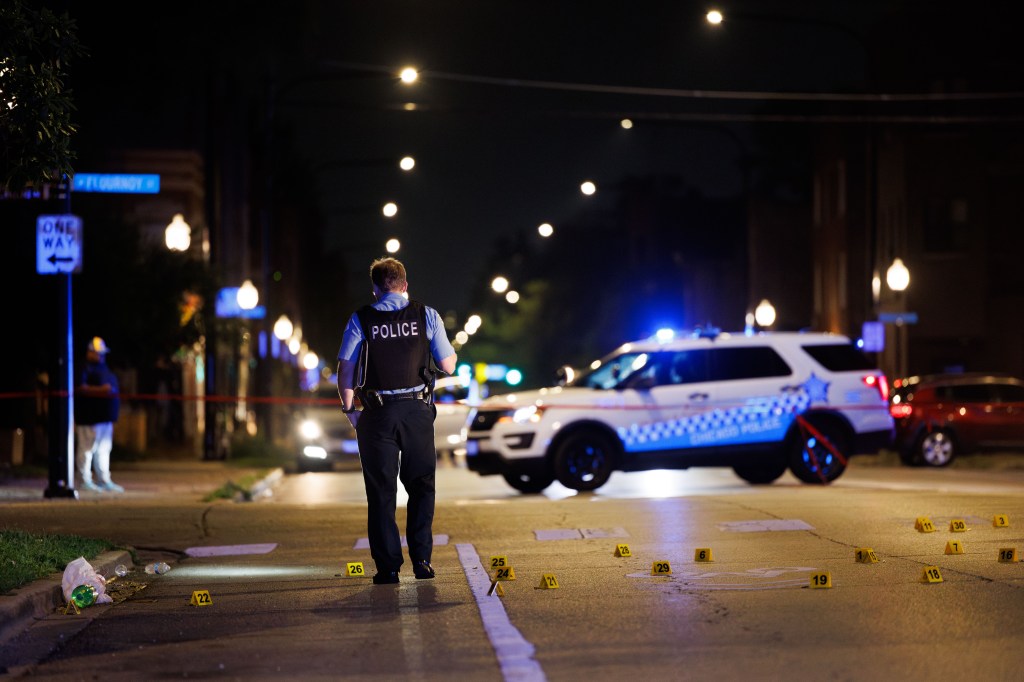Mayor Brandon Johnson and his administration are touting reductions in homicides and other violent crime in Chicago as proof that his safety plan is working. However, in some neighborhoods, residents do not believe that crime is down.
Two-thirds of Chicago residents are concerned about public safety in the area where they live, a 2024 Harris Poll found. The data in distressed neighborhoods is bucking the midyear national trend of reductions in violent crime across the country. Austin, the neighborhood Johnson calls home, leads the city with 29 homicides so far this year. In 2024, Austin finished the year with 47 homicides.
In too many neighborhoods, people feel unsafe. The following neighborhoods lead the city in homicides and shooting victims: Austin, Englewood, Garfield Park, South Shore, North Lawndale and Auburn Gresham. These neighborhoods are predominantely African American.
I am appalled that more than 75% of the victims of gun violence are young Black men and boys. African Americans account for 28% of the city’s population. The Black community does not feel a 30% drop in homicides and nonfatal shootings — because their neighborhoods remain places with high violence. Aretha Franklin, the singer, had it right: You have to give the people “something they can feel.”
The city of Chicago data notes that 18% of the fatal and nonfatal victims of gun violence are Latino and 2.4% are white. Thirty-nine percent of the Chicago population is white. Why is there so much violence in Black communities and very little in predominately white areas?
In white communities, there is economic stability. A dollar circulates six hours in an African American community, compared with 17 days in a white community, 19 days in a Jewish community and 28 days in an Asian community. Building wealth in the Black community will lead to economic stability and likely lower crime rates. The mayor’s policies supporting red light and speed cameras, parking tickets and high taxes could be causing economic hardship and anger. Economic instability coupled with high poverty, unemployment and poor-performing schools are a recipe for disaster.
How can Johnson celebrate reductions in violence when his community is in crisis? Over 50% of the people being shot in Chicago are young, from children to adults who up to 29 years old. Our young people represent the future.
Some of the teen gatherings downtown have led to violence and property damage. I believe the City Council rightly passed an ordinance to address this issue. Unfortunately, the mayor vetoed the legislation. Johnson should get out of the way and allow Chicago police Superintendent Larry Snelling to do his job. The superintendent is respected by his peers and the community. I believe if he were allowed to do his job without political interference, more cases would be solved and communities made safer.
I understand what it is like to be a victim of violent crime. I lost my 20-year-old son, Omar, to gun violence. It is a pain that stays with surviving family members. That pain is made worse when the perpetrators are not brought to justice. While crime numbers are trending down, if people are victimized and no one is held accountable, that amplifies gun violence in high-crime areas and sends a signal to criminals that community safety is not a priority.
Block Club Chicago and The Trace recently reported that the city’s homicide clearance rate is still declining, even with fewer homicides to solve. In 2024, police made arrests in 16% of fatal shootings within a year of the incident, down from 23% in 2022. Eighty percent of Chicago’s fatal shooting victims were Black, and their cases had a significantly lower clearance rate. Thus, families do not have closure, and no one has been held accountable for shooting their loved one.
The following are suggestions to curb violence in African American neighborhoods:
- Johnson, Cook County Board President Toni Preckwinkle and Gov. JB Pritzker should use procurement opportunities to stabilize the South and West sides.
- Johnson, Preckwinkle and Pritzker should focus resources to address substance abuse, health and food deserts on the South and West sides.
- Elected leaders should give parents the support they need to raise their children in safe neighborhoods with quality schools.
- Pritzker, Johnson and Preckwinkle should announce a public works program around removing lead pipes from homes and employ people from the South and West sides. Lead poisoning through drinking water or paint could cause significant harm to a child’s brain development.
- Johnson should give Snelling the authority to call a snap curfew to address teen takeovers.
- Elected leaders should increase funding for victim and witness protection programs.
Residents living on the South and West sides should not be living in fear. They deserve full-service grocery stores, banks and manufacturing facilities with well-paying jobs.
The highest concentration of people returning from prisons across Illinois reside on the West and South sides. Elected leaders must provide investments in job training, vocational education and other wraparound services for individuals returning from prisons.
The data is not always the best predictor of safe neighborhoods. The people living in those communities know when they are safe — they can feel it.
I write this commentary to make those comfortable celebrating violence reduction statistics uncomfortable.
Willie Wilson is a business owner, philanthropist and former mayoral candidate.
Submit a letter, of no more than 400 words, to the editor here or email letters@chicagotribune.com.
